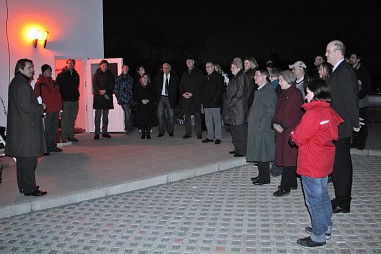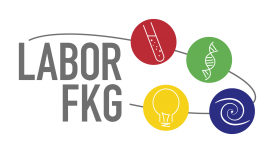Die im Dezember 2009 eingeweihte Sternwarte erhielt nach einer mehr als zweijährigen Planungs- und Einrichtungsphase nun zukünftiges Hauptinstrument. Das CDK 20 von PlaneWave Instruments ist ein nach Dall-Kirkham modifiziertes Cassegrain-Teleskop mit einem zusätzlichen Korrektor. Das Teleskop wird von einer GM 4000 QCI-Montierung der italienischen Firma 10Micron getragen. Die Montierung führt das Teleskop hochpräzise der scheinbaren Bewegung des Himmels nach.
Teleskop und Montierung wurden von der Universität Würzburg angeschafft, denn dieses besondere Instrument wird nicht nur von Schülerinnen und Schülern des FKG sondern auch von Studierenden der Universität Würzburg im Rahmen von Seminaren und astronomischen Praktika genutzt. Wie alle Einrichtungen des Naturwissenschaftlichen Labors für Schüler am FKG steht die Sternwarte zudem Schülern anderer Schulen offen.
Das neue Teleskop ist Herzstück des Kooperationsprojektes „Helligkeitsschwankungen aktiver Galaxienkerne“. Bei diesem bundesweit wohl einmaligen Projekt messen Schülerinnen und Schüler des Schülerlabors gemeinsam mit Wissenschaftlern des Lehrstuhls für Astronomie in regelmäßigen Abständen die Helligkeit der Zentren ausgewählter Galaxien. Mit Hilfe dieser Daten können die Massen und Abstände der beiden Schwarzen Löcher bestimmt werden, die als zentrale Maschine in den Zentren aktiver Galaxienkerne vermutet werden. Diese Messungen ergänzen die Forschungsarbeit der Arbeitsgruppe um Prof. Dr. Karl Mannheim, die mit dem MAGIC-Teleskopsystem auf La Palma dieselben Objekte im Gammastrahlenbereich untersucht. Durch diese Einbindung von Schülerinnen und Schülern in aktuelle Forschung werden diese für die Naturwissenschaften begeistert, was den Weg für ein naturwissenschaftliches Studium bereitet.
Ergänzt wird das Spiegelteleskop durch ein Linsenteleskop mit einer Öffnungsweite von 12 Zentimetern. Der apochromatische Refraktor ED 120 der Firma Sky-Watcher dient zur Beobachtung von Objekten mit größerer Winkelausdehnung und fungiert gleichzeitig als Leitrohr, mit dessen Hilfe das Spiegelteleskop mit höchster Präzision gesteuert werden kann. Dieses Teleskop konnte durch die Unterstützung des Verein der Freunde des FKG e.V. angeschafft werden.
Bei der Einweihung eines größeren Teleskops – der nun aufgestellte Astrograph gehört zu den größeren Instrumenten seiner Art in Nordbayern – gibt es stets den feierlichen Moment der ersten astronomischen Beobachtung: das sogenannte „First Light“, also das erste Sternenlicht, das auf den Spiegel fällt, nachdem das Teleskop aufgestellt, ausgerichtet und justiert wurde. Zu diesem Ereignis hatten sich neben zahlreichen Schülerinnen und Schülern sowie Studierenden auch Eltern, Lehrkräfte, der Vorstand des Fördervereins des FKG sowie Wissenschaftler und Professoren der Fakultät für Physik eingefunden. Die Gemeinde Hettstadt, die das Grundstück für die Sternwarte zur Verfügung gestellt hat, wurde durch Bürgermeister Eberhard Götz vertreten.
Das „First Light“ war auch Anlass, der Sternwarte einen Namen zu geben. Als Namenspatron wurde der erste Lehrstuhlinhaber für Astronomie an der Universität Würzburg und einer der Wegbereiter der europäischen Südsternwarte (ESO), Prof. Dr. Hans Haffner gewählt. Professor Haffner wirkte von 1967 bis zu seinem Tode im Jahr 1977 an der Universität Würzburg und war auch maßgeblich an der Einrichtung der ehemaligen Universitäts- und heutigen Volkssternwarte in der Keesburg beteiligt. Zur Namensverleihung verlas der Amtsnachfolger Haffners, Prof. Dr. Karl Mannheim, auch einen handschriftlichen Brief der Witwe, Friedhilde Haffner, in dem sie sich für die Ehrung der Verdienste ihres Mannes bedankte und der Namensgebung sehr gerne zustimmte.
In den ersten Wochen nach dem First Light konnten Schülerinnen und Schüler sowie Studierende der Universität Würzburg erste praktische Erfahrungen an diesem Teleskop sammeln. Auch das Forschungsprojekt konnte nun nach Monaten der theoretischen Vorbereitung und Einarbeitung der Schüler in die Praxisphase eintreten.
Ganz im Sinne Haffners ist die Sternwarte also jetzt ein Ort, an dem junge Menschen – Schülerinnen und Schüler gleichermaßen wie Studierende – erstmals mit dem faszinierenden Feld der praktischen Himmelsforschung in Berührung kommen können.



